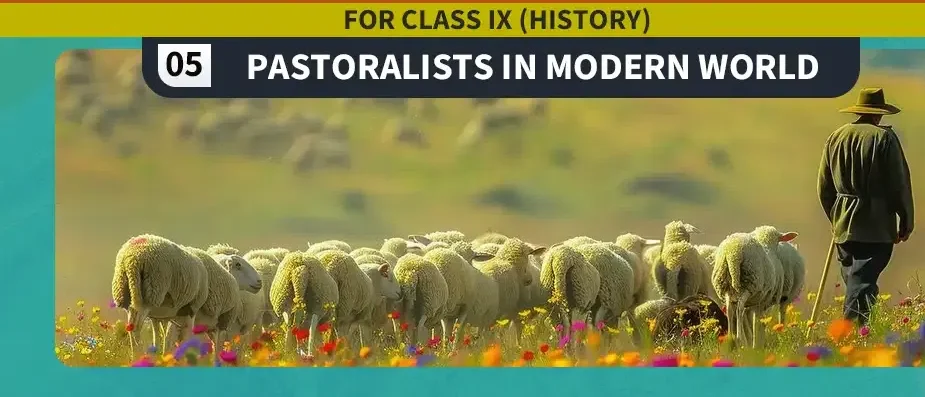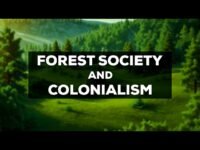🔹 1. Introduction
- Pastoralists are communities who rear livestock for their livelihood.
- They move from one place to another in search of pasture and water.
- Found in arid, semi-arid, and hilly regions of the world.
- Colonialism, modern states, and market economy affected their lifestyle.
Summary (60–70 Words):
Pastoralists are nomadic or semi-nomadic communities that depend on livestock for livelihood. They move seasonally to find grazing land and water. Modern states, colonial policies, and commercialization restricted their movements and access to pastures. Despite challenges, pastoralists adapted through trade, seasonal migration, and social networks. Their traditional knowledge and practices sustain livestock in harsh environments, showing the resilience of pastoral societies in the modern world.
🔹 2. Life of Pastoralists
- Livelihood: Depend on sheep, goats, camels, cattle, yaks.
- Mobility: Seasonal migration (transhumance) in search of pasture.
- Housing: Temporary shelters like tents or huts.
- Social structure: Families or clans, led by elders or chiefs.
- Trade and barter: Milk, wool, hides sold in markets.
- Adaptation: Knowledge of climate, grazing patterns, animal care.
🔹 3. Impact of Modern States and Colonization
- Colonial policies: Restricted pasture, imposed taxes, encouraged settled agriculture.
- Modern states: Fencing, national parks, development projects limit movement.
- Market economy: Pastoralists sell products for cash, some become semi-settled.
- Education and healthcare: Modern amenities introduced slowly.
- Challenges: Loss of pasture, water scarcity, conflicts with farmers.
🔹 4. Adaptation and Resilience
- Mobility helps survival in harsh environments.
- Social networks aid in resource sharing.
- Pastoralists adopt new technology for livestock care.
- Community festivals and traditions preserve cultural identity.
- Some combine pastoralism with settled farming.
🔹 5. Key Terms
- Pastoralism: Livestock-based livelihood.
- Transhumance: Seasonal migration of herders.
- Semi-nomadic: Partially settled, partially mobile.
- Colonial policies: Restrictions on traditional movements.
- Adaptation: Adjusting to environmental and social changes.
✅ Multiple Choice Questions (MCQs)
- Pastoralists primarily depend on:
a) Farming b) Industry c) Livestock d) Fishing - What is transhumance?
a) Permanent settlement b) Seasonal migration for pasture c) Hunting d) Trade - Pastoralists are mostly found in:
a) Cities b) Plains c) Arid, semi-arid, and hilly regions d) Forests - Colonial policies affected pastoralists by:
a) Supporting them b) Restricting pastures and imposing taxes c) Giving education d) Promoting livestock - Housing of pastoralists includes:
a) Stone houses b) Tents or huts c) Palaces d) Apartments - Social structure of pastoralists is usually:
a) Families or clans b) Castes c) Nations d) Corporations - Pastoralists sell:
a) Oil b) Milk, wool, hides c) Electronics d) Food grains - Modern states limit pastoral movement by:
a) Fencing and development projects b) Education c) Tourism d) Technology - Semi-nomadic pastoralists:
a) Fully mobile b) Fully settled c) Partially settled, partially mobile d) Not mobile - Main challenges for pastoralists today:
a) Famine only b) Water scarcity, loss of pasture, conflicts c) Disease only d) Urbanization only - Adaptation strategies include:
a) Migration, trade, technology b) Stopping migration c) Selling land d) Hunting - Colonialism encouraged:
a) Pastoralism b) Settled agriculture c) Migration d) Festivals - Knowledge of climate and grazing helps:
a) Only trade b) Livestock survival c) Education d) Technology - Cultural identity preserved through:
a) Schools b) Festivals and traditions c) Markets d) Government - Pastoralists sometimes combine livestock rearing with:
a) Fishing b) Farming c) Mining d) Manufacturing
✅ Assertion and Reason Questions
Q1.
- Assertion (A): Pastoralists move seasonally.
- Reason (R): They need pasture and water for livestock.
a) Both A and R true, R correct explanation of A
b) Both A and R true, R not correct explanation of A
c) A true, R false
d) A false, R true
Q2.
- Assertion (A): Colonial policies restricted pastoral movement.
- Reason (R): Colonies imposed taxes and promoted settled agriculture.
a) Both A and R true, R correct explanation of A
b) Both A and R true, R not correct explanation of A
c) A true, R false
d) A false, R true
Q3.
- Assertion (A): Pastoralists sell milk, wool, and hides.
- Reason (R): These products provide income in the market economy.
a) Both A and R true, R correct explanation of A
b) Both A and R true, R not correct explanation of A
c) A true, R false
d) A false, R true
Q4.
- Assertion (A): Pastoralists face conflicts with farmers today.
- Reason (R): Fencing, development projects, and loss of pastures cause disputes.
a) Both A and R true, R correct explanation of A
b) Both A and R true, R not correct explanation of A
c) A true, R false
d) A false, R true
Q5.
- Assertion (A): Adaptation ensures survival of pastoralists.
- Reason (R): Mobility, social networks, and technology help them cope with challenges.
a) Both A and R true, R correct explanation of A
b) Both A and R true, R not correct explanation of A
c) A true, R false
d) A false, R true
🧠 Case-Based Study Questions
Case Study 1:
Pastoralists rear livestock and move seasonally.
- What is their primary livelihood?
- What is seasonal migration called?
- Why do they move?
- How do they house themselves?
- Who leads pastoral communities?
Case Study 2:
Colonial policies restricted access to pastures and imposed taxes.
- Which policies affected pastoralists?
- How did colonialism restrict them?
- Why were taxes imposed?
- Did pastoralists benefit from these policies?
- What was the main goal of colonial states?
Case Study 3:
Modern states limit pastoral mobility through fencing, parks, and development projects.
- Name one modern restriction on pastoral movement.
- How does fencing affect pastoralists?
- What happens to seasonal migration?
- How does government development affect pastures?
- What is a major challenge for pastoralists today?
Case Study 4:
Pastoralists sell milk, wool, and hides in markets.
- Name three products sold by pastoralists.
- How do they earn income?
- How does the market economy influence them?
- Are they fully settled or semi-nomadic?
- Why is trade important for survival?
Case Study 5:
Pastoralists adapt using migration, social networks, and technology.
- How does mobility help pastoralists?
- What role do social networks play?
- Name one technology used in livestock care.
- How do festivals preserve culture?
- Can pastoralists combine livestock with farming?
15 Reason-Based Questions
- Why do pastoralists migrate seasonally?
- What is transhumance?
- How are pastoral communities organized?
- What are the main products of pastoralism?
- How do pastoralists adapt to harsh environments?
- How did colonial policies affect pastoralists?
- Why did development projects limit pastoral mobility?
- How does fencing create conflict with farmers?
- How do pastoralists use social networks?
- What are semi-nomadic pastoralists?
- How does technology help pastoralists today?
- Why are festivals important for pastoralists?
- How does market economy change pastoral practices?
- What challenges do pastoralists face in modern times?
- Can pastoralism and
Answer Key
MCQs
- c) Livestock
- b) Seasonal migration for pasture
- c) Arid, semi-arid, and hilly regions
- b) Restricting pastures and imposing taxes
- b) Tents or huts
- a) Families or clans
- b) Milk, wool, hides
- a) Fencing and development projects
- c) Partially settled, partially mobile
- b) Water scarcity, loss of pasture, conflicts
- a) Migration, trade, technology
- b) Settled agriculture
- b) Livestock survival
- b) Festivals and traditions
- b) Farming
Assertion & Reason
- a) Both A and R true, R correct explanation of A
- a) Both A and R true, R correct explanation of A
- a) Both A and R true, R correct explanation of A
- a) Both A and R true, R correct explanation of A
- a) Both A and R true, R correct explanation of A
Case-Based Questions
Case Study 1:
- Livestock rearing
- Transhumance
- Search for pasture and water
- Tents or huts
- Elders or chiefs
Case Study 2:
- Colonial policies
- Restricted pastures, limited movement
- Revenue collection
- No, they mostly suffered
- Economic control of land and livestock
Case Study 3:
- Fencing, national parks, development projects
- Restricts grazing areas
- Seasonal migration reduced
- Pastures limited, livestock affected
- Loss of pasture, water scarcity
Case Study 4:
- Milk, wool, hides
- Sold in local markets for income
- Encourages semi-settled lifestyle, cash income
- Semi-nomadic
- Provides necessary income and survival
Case Study 5:
- Allows access to pastures and water
- Helps share resources and coordinate migration
- Mobile veterinary care, fodder management tools
- Preserve cultural identity and community bonding
- Yes, some combine livestock with farming
Reason-Based Questions
- Pastoralists migrate to find pasture and water for livestock.
- Transhumance is seasonal migration of herders to different pastures.
- Organized as families or clans, led by elders or chiefs.
- Main products: milk, wool, hides, sometimes meat.
- Adaptation includes knowledge of climate, grazing, and animal care.
- Colonial policies restricted movement and imposed taxes to control land.
- Development projects like fencing, roads, and parks limit mobility.
- Fencing prevents livestock from grazing, causing conflicts with farmers.
- Social networks help share information, resources, and coordinate migration.
- Semi-nomadic pastoralists are partially settled but migrate seasonally.
- Technology helps in veterinary care, fodder management, and communication.
- Festivals preserve traditions, strengthen community bonds, and cultural identity.
- Market economy allows pastoralists to sell products for cash, influencing lifestyle.
- Challenges include loss of pasture, water scarcity, conflicts, and modernization pressures.
- Many pastoralists combine livestock rearing with farming for additional livelihood.



